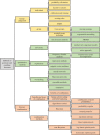A survey of human judgement and quantitative forecasting methods
- PMID: 33972849
- PMCID: PMC8074796
- DOI: 10.1098/rsos.201187
A survey of human judgement and quantitative forecasting methods
Abstract
This paper's top-level goal is to provide an overview of research conducted in the many academic domains concerned with forecasting. By providing a summary encompassing these domains, this survey connects them, establishing a common ground for future discussions. To this end, we survey literature on human judgement and quantitative forecasting as well as hybrid methods that involve both humans and algorithmic approaches. The survey starts with key search terms that identified more than 280 publications in the fields of computer science, operations research, risk analysis, decision science, psychology and forecasting. Results show an almost 10-fold increase in the application-focused forecasting literature between the 1990s and the current decade, with a clear rise of quantitative, data-driven forecasting models. Comparative studies of quantitative methods and human judgement show that (1) neither method is universally superior, and (2) the better method varies as a function of factors such as availability, quality, extent and format of data, suggesting that (3) the two approaches can complement each other to yield more accurate and resilient models. We also identify four research thrusts in the human/machine-forecasting literature: (i) the choice of the appropriate quantitative model, (ii) the nature of the interaction between quantitative models and human judgement, (iii) the training and incentivization of human forecasters, and (iv) the combination of multiple forecasts (both algorithmic and human) into one. This review surveys current research in all four areas and argues that future research in the field of human/machine forecasting needs to consider all of them when investigating predictive performance. We also address some of the ethical dilemmas that might arise due to the combination of quantitative models with human judgement.
Keywords: forecast combination; forecasting; human judgment; quantitative forecasting methods.
© 2021 The Authors.
Figures






References
-
- Einhorn HJ. 1972. Alchemy in the behavioral sciences. Public Opin. Q. 36, 367-378. (10.1086/268019) - DOI
-
- Makridakis S, Spiliotis E, Assimakopoulos V. 2018. The M4 Competition: results, findings, conclusion and way forward. Int. J. Forecast. 34, 802-808. (10.1016/j.ijforecast.2018.06.001) - DOI
-
- Armstrong JS, Green KC. 2018. Forecasting methods and principles: evidence-based checklists. J. Global Scholars of Mark. Sci. 28, 103-159. (10.1080/21639159.2018.1441735) - DOI
-
- Armstrong JS, Green KC, Graefe A. 2015. Golden rule of forecasting: be conservative. J. Bus. Res. 68, 1717-1731. (10.1016/j.jbusres.2015.03.031) - DOI
Publication types
LinkOut - more resources
Full Text Sources
Other Literature Sources

